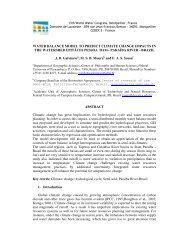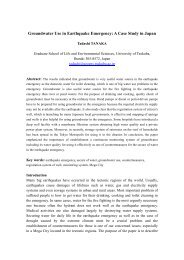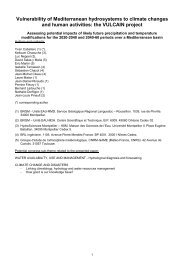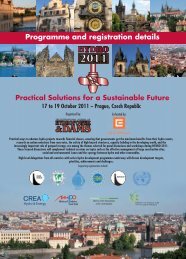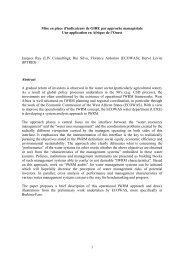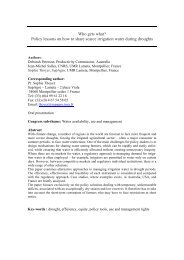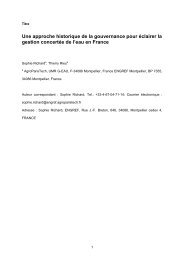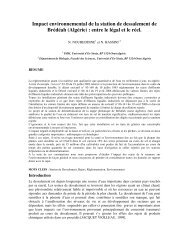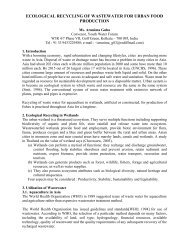HYDRAULIC MODEL OF TRICKLE-IRRIGATION LATERALS - IWRA
HYDRAULIC MODEL OF TRICKLE-IRRIGATION LATERALS - IWRA
HYDRAULIC MODEL OF TRICKLE-IRRIGATION LATERALS - IWRA
You also want an ePaper? Increase the reach of your titles
YUMPU automatically turns print PDFs into web optimized ePapers that Google loves.
determined using the least square method at a given inlet flow rate of lateral and at an<br />
inlet pressure head of lateral. The Darcy-Weisbach equation for head loss due to friction<br />
is used too. The friction coefficient is considered as a function of Reynolds number for<br />
different flow conditions (from laminar to fully turbulent).<br />
Kosturkov and Simeonov (1990), have developed a model of designing<br />
horizontal, non- deformable trickle lateral on the basis of the momentum approach. The<br />
longitudinal projection of discharged velocity is considered as a linear function of the<br />
averaged flow velocity. An analytical decision of the two differential equations obtained<br />
is proposed (the momentum equation and the conservation of mass equation) (Kosturkov,<br />
1990).<br />
Yildirim and Agiralioglu (2004) have performed a good comparative analysis of<br />
the developed hydraulic methods in design of microirrigation laterals.<br />
Von Bernurth (1990), Holzapfel et al. (1990), Bagarello et al. (1995) take into<br />
account the influence of temperature on the viscosity change in the hydraulic design of<br />
drip irrigation system. It is proved that when the water temperature changes from 15,5º C<br />
to 37,7º C (from 60º F to 100º F) the density decreases by less than 1% but viscosity<br />
decreases by about 40% (Munson, Young and Okishi, 1990). That is why the influence of<br />
temperature and Reynolds number will be taken into account when the change of water<br />
kinematic viscosity is considered.<br />
The objective of the work presented in this paper is a model derivation for<br />
hydraulic design of a drip lateral on the basis of theory of spatially varied flow and with<br />
application in the drip irrigation practice.<br />
2. Theoretical backgrounds of the developed model of trickle irrigation<br />
laterals<br />
The deduced model by Petrov (1951) is an one-dimensional hydraulic equation,<br />
based on the momentum approach. It describes a steady spatially varied flow with<br />
dz<br />
averaged velocities, and inconstant flow area at slope with a gradient . The head loss<br />
dx<br />
due to friction is calculated by means of the formula of Darsy-Weisbach that is accurate<br />
for a small diameter smooth pipes. The pipe is considered as non-deformable one. In the<br />
case of lateral outflow along the pipe with a constant diameter, the equation is as follows:<br />
2<br />
1 dp dV dz V 1 ( V −θ<br />
) V dQ<br />
+ α V + + λ + α<br />
= 0 , (1)<br />
ρ dx dx dx 2 D Q dx<br />
where: V is the averaged flow velocity throughout the cross-section; p is the pressure<br />
assumed to be constant throughout the cross-section; α is a coefficient of Boussinesq; θ<br />
is the longitudinal projection of discharged velocity , θ = δV<br />
; δ is a coefficient of<br />
proportionality between the longitudinal projection of discharged velocity and the<br />
3<br />
averaged flow velocity throughout the cross-section; Q is the flow rate in m / s ; γ is the<br />
specific weight of water, γ = ρ g (for incompressible fluid); g - gravity acceleration.<br />
The last term of the equation (1) reports discharging the flow along the lateral<br />
length according to the theory of Meshterski (Petrov, 1951) and the previous term<br />
represents the head loss due to the friction per unit length.<br />
Taking into account the outflow at a distance between emitters s , the equation of<br />
the conservation of mass is as follows:<br />
2



